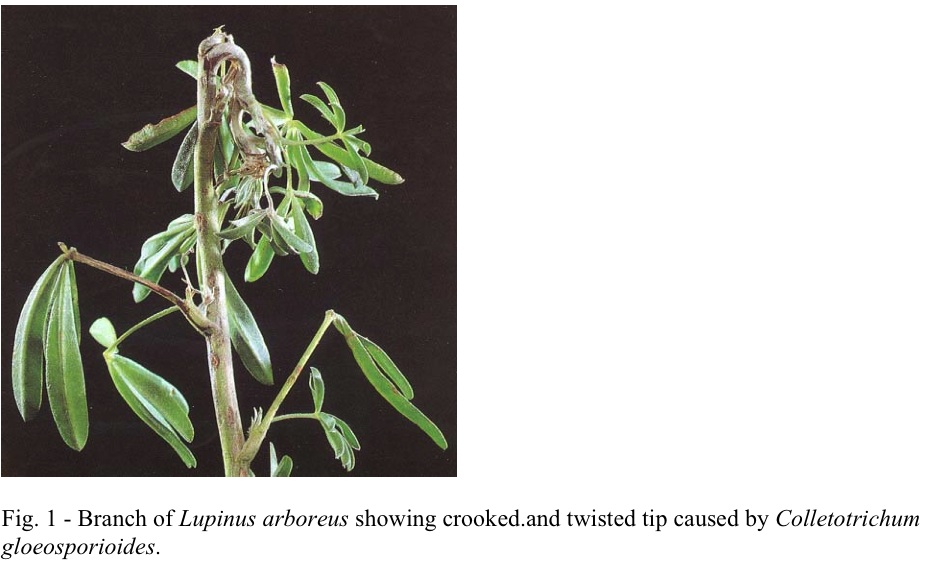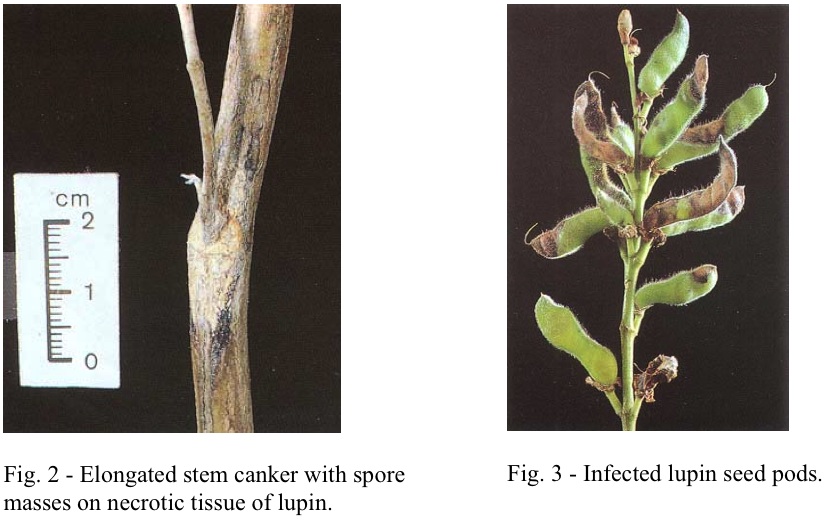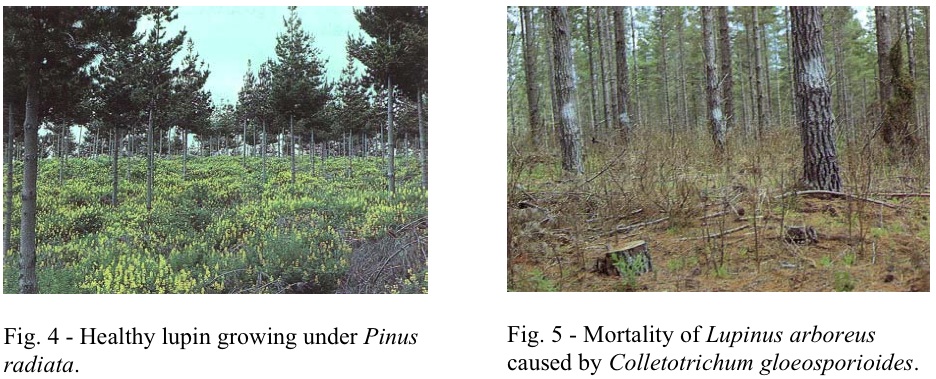PESTS AND DISEASES OF FORESTRY IN NEW ZEALAND
Lupin blight
Scion is the leading provider of forest-related knowledge in New Zealand
Formerly known as the Forest Research Institute, Scion has been a leader in research relating to forest health for over 50 years. The Rotorua-based Crown Research Institute continues to provide science that will protect all forests from damage caused by insect pests, pathogens and weeds. The information presented below arises from these research activities.
Forest Pathology in New Zealand No. 22,
Lupin blight.
Based on M. Williams (1993)
Causal organism
Colletotrichum gloeosporioides Penzig

Colletotrichum gloeosporioides is a species complex with morphologically identical strains restricted to a particular host plant or group of plants. This strain of C. gloeosporioides appears to be restricted to Lupinus spp.
Type of injury
Infects stems, branches, leaves, petioles, and seedpods causing leaf loss, dieback, shoot distortion, and mortality of whole plant.
Diagnostic features
- Branches and stems twisted or crooked.
- Withering of leaves and petioles followed by premature casting of foliage.
- Elongated, lens-shaped, and slightly sunken, stem and branch cankers.
- Basal cankers distorted and swollen with cracks and internal brown staining.
- Seed pods flattened and necrotic.
- Salmon-pink spore masses on necrotic tissue.
- Branch and stem breakage at cankers.
Hosts
Lupinus angustifolius, Lupinus arboreus, Lupinus cosentinii, Lupinus pubescens.
Distribution
Throughout New Zealand.

Disease development
The fungus overwinters in plant debris on the ground and spores are aerially dispersed. Spore infection occurs after a period of warm wet weather.
The fungus attacks plants of all ages, and all aboveground plant parts are susceptible to infection. Infected leaves and petioles wither and much of the foliage is cast. After infection a crooking of succulent stems and branches occurs, which in the early stage is not associated with visible lesions. Lens-shaped lesions up to 3 cm long develop on branches and stems, particularly at branch axils. Salmon-pink spore masses develop on the lesions when the weather is warm and wet. Older plants with a woody stem often develop cankers at ground level. These cankers appear as a distorted swollen area with external cracks and internal brown staining. When there is substantial dieback and/or severe basal cankers, plants will die. Death of plants infected while in the cotyledon stage or when only the first few leaflets have developed is inevitable and rapid. The fungus also attacks seed pods which become flattened and necrotic, with the pink fruiting bodies visible on the outside. Seed production is markedly reduced.
Economic importance
The yellow tree lupin Lupinus arboreus has been utilised in New Zealand for its nitrogen- fixing capabilities for many years. Lupin has been vital for the growth and continued health of Pinus radiata in sand dune forestry. Lupin regenerates naturally after each thinning and harvesting operation, and until the advent of the disease it was self-sustaining once it had become established in an area.
In coastal areas where programmes of sand dune stabilisation took place, lupin seed was sown between rows of the sand-binding marram grass Ammophila arenaria. Not only did the lupin supply nitrogen by the symbiotic bacterial fixation of atmospheric nitrogen, but also it had the ability to survive and do well in the harsh environment of a windblown sand dune and it was not palatable to browsing animals.

Although the disease was first recognised in 1989, anecdotal evidence suggests that it was present for at least 2 years prior to that. A national survey of lupin populations conducted in early 1990 estimated that previously-established lupin had been reduced by 90-95% in the North Island and the northern half of the South Island, and in other parts of the South Island 60-65% of lupins had died. To some small degree there has been a recovery of the lupin population throughout the country but nowhere has it attained its previous vigour. In the northern sand dune forests monitoring has shown infection levels in years subsequent to 1989 to be quite high, and mortality as a result of the disease is still in the region of 80% per annum.
Loss of lupin from the 60 000 ha of exotic forests planted on sand dunes threatens the productivity of those forests. With a substantial reduction in the supply of nitrogen, the prospects for these forests are stagnation of tree growth in older stands, failure of young stands to become productive, and a risk of reversion to drifting sand dunes in exposed areas.
Control
On an experimental scale the fungicide chlorothalonil gave good control of lupin blight when applied at a rate of 1.5 kg/ha at fortnightly intervals. The logistics of aerial spray applications to control lupin blight would be difficult, the cost high, and where lupins are growing amongst trees, or other tall vegetation, spray deposition on lupin would be much reduced. Emphasis is now being placed on selecting a range of alternative nitrogen-fixing plants, with different species being targeted for each site, to supplement the surviving lupin.
Bibliography
Beets, P.N.; Madgwick, H.A.I. 1988: Above-ground dry matter and nutrient content of Pinus radiata as affected by lupin, fertiliser, thinning, and stand age. New Zealand Journal of Forestry Science 18: 43-64.
Jackson, D.S.; Gifford, H.H.; Graham, J.D. 1983: Lupin, fertiiiser, and thinning effects on early productivity of Pinus radiata growing on deep Pinaki sands. New Zealand Journal of Forestry Science 13:159-182.
Williams, M. 1993: Lupin blight. New Zealand Forest Research Institute, Forest Pathology in New Zealand No. 22.
Compiled: 1993
This information is intended for general interest only. It is not intended to be a substitute for specific specialist advice on any matter and should not be relied on for that purpose. Scion will not be liable for any direct, indirect, incidental, special, consequential or exemplary damages, loss of profits, or any other intangible losses that result from using the information provided on this site.
(Scion is the trading name of the New Zealand Forest Research Institute Limited.)

 Farm Forestry New Zealand
Farm Forestry New Zealand

